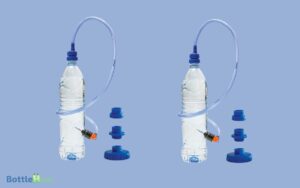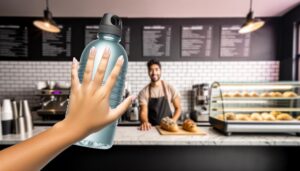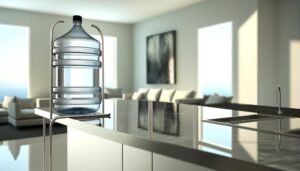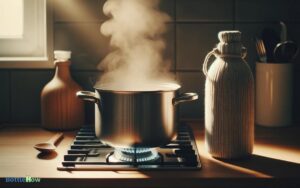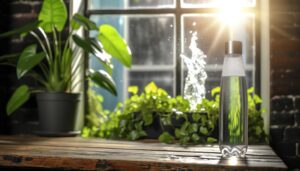Water Bottle Is How Many Ounces
A typical water bottle holds between 8 ounces and 32 ounces, suiting varied hydration needs. Smaller 8-12 ounce bottles are perfect for quick bursts of activity.
Medium bottles, ranging from 16-24 ounces, strike a balance between portability and capacity, making them ideal for moderate activities. For extended or demanding tasks, consider a larger 32-40 ounce bottle.
Checking volume markings or using a measuring cup guarantees precise fluid tracking. Accurate bottle size assists in optimizing your daily water intake, enhancing overall hydration.
Curious about selecting the best bottle size and tips for staying hydrated?
Key Takeaways
- Common water bottle sizes range from 8 ounces to 32 ounces.
- Small bottles hold 8-12 ounces for short outings.
- Medium bottles hold 16-24 ounces for moderate activities.
- Large bottles hold 32-40 ounces for extended activities.
- Bottle capacity helps track water intake and hydration levels.
Common Water Bottle Sizes
When discussing common water bottle sizes, you'll find that they typically range from 8 ounces to 32 ounces, catering to various hydration needs.
An 8-ounce bottle is perfect for short outings, fitting easily in small bags.
The 16-ounce variant suits moderate activities, providing a balance between portability and adequate hydration.
For more extended activities or higher hydration needs, 24-ounce and 32-ounce bottles are ideal. These larger sizes guarantee you stay hydrated without frequent refills.
Precise measurements in fluid ounces help you track your intake accurately.
Whether you're at the gym, hiking, or simply at work, the variety guarantees there's a bottle size that complements your lifestyle, fostering a sense of community among those who prioritize their hydration.
Why Bottle Capacity Matters
Understanding why bottle capacity matters is essential for optimizing hydration and ensuring you meet your daily fluid intake requirements efficiently. When you know the exact capacity of your water bottle, you can better track your water consumption, which is vital for maintaining peak health.
A larger bottle means fewer refills, reducing disruptions during your busy day. Conversely, a smaller, more portable bottle is ideal for short trips or activities. Bottle capacity also influences temperature retention—larger bottles often have better insulation.
Measuring Your Water Bottle
To effectively monitor your fluid intake, it's important to know how to measure the capacity of your water bottle accurately. Start by locating the volume markings on the bottle; these are often in both ounces and milliliters.
If your bottle lacks markings, use a graduated measuring cup. Fill the cup to a precise volume, then pour it into the bottle, repeating until full. Add up the volumes to determine the bottle's capacity.
For irregular shapes, consider using a kitchen scale to weigh the water, converting grams to ounces (1 fluid ounce equals approximately 29.57 grams). This scientific approach guarantees you're accurately tracking your hydration, fostering a sense of achievement and community among those committed to health and wellness.
Small Bottles: 8-12 Ounces
Small bottles, typically holding 8-12 ounces, are convenient for quick hydration and easy to carry throughout your day. You'll find they're perfect for short trips, quick workouts, or when you just need a small refreshment.
Here's why they're effective:
- Portability: These bottles fit easily in bags, purses, and even large pockets, making them ideal for on-the-go hydration.
- Portion Control: An 8-12 ounce bottle helps you manage your water intake, ensuring you stay hydrated without over-consuming.
- Environmental Impact: Smaller bottles can be reused multiple times, reducing waste and promoting sustainable habits.
Medium Bottles: 16-24 Ounces
Medium bottles, holding 16-24 ounces, strike a balance between portability and capacity, ideal for longer activities and maintaining hydration throughout the day. You’ll find these bottles perfect for gym sessions, hiking trips, or extended office hours. Their size allows you to carry a substantial amount of water without the bulk, fitting easily into backpacks or cup holders. Many medium bottles also come with ergonomic designs and leak-proof lids, making them convenient for daily use. When considering water bottle sizes for cup holders, these bottles often fit snugly, ensuring easy access while driving or working. Their versatility makes them a popular choice for those who need a reliable hydration companion without compromising on portability.
Scientifically, consuming water in this range supports peak body function, aiding in thermoregulation, joint lubrication, and nutrient transport. By choosing a medium bottle, you're ensuring you meet daily hydration needs while staying mobile.
These bottles often come with features like insulation, spouts, or handles, enhancing usability. Embrace the convenience and efficiency of medium bottles to stay hydrated and active throughout your day.
Large Bottles: 32-40 Ounces
Large bottles, holding 32-40 ounces, offer a robust solution for those who need sustained hydration throughout demanding activities or lengthy periods away from water sources. You'll find these bottles invaluable for:
- Outdoor adventures: Whether hiking or camping, a large bottle guarantees you stay hydrated.
- Extended workouts: For those long gym sessions or marathon training, it maintains your water intake consistent.
- Daily commutes: If you're constantly on the go, carrying a 32-40 ounce bottle can help fulfill your daily hydration needs.
These bottles are scientifically designed to balance capacity and portability, making them ideal for diverse activities.
Extra Large Bottles: 48-64 Ounces
For those seeking even greater hydration capacity, extra large bottles, holding 48-64 ounces, provide an unparalleled solution for prolonged activities and extensive periods without access to water. These bottles are perfect for long hikes, extended workouts, or busy days. They help you stay hydrated without frequent refills, maintaining peak bodily functions and performance levels.
| Bottle Size (oz) | Approx. Liters | Suitable For |
|---|---|---|
| 48 | 1.42 | Long Hikes |
| 52 | 1.54 | Extended Workouts |
| 56 | 1.65 | Busy Office Days |
| 60 | 1.77 | Outdoor Adventures |
| 64 | 1.89 | Day-long Excursions |
These bottles are engineered for durability and efficiency, making them indispensable for anyone serious about their hydration. Whether you're an athlete, an office worker, or an adventurer, these bottles fit seamlessly into your routine.
Choosing the Right Size
Selecting the appropriate water bottle size involves analyzing your daily hydration needs, activity levels, and environmental conditions to guarantee peak performance and well-being. To make an informed choice, consider the following factors:
- Daily Hydration Needs: Calculate your daily water intake based on body weight, typically 0.5-1 ounce per pound. For example, if you weigh 150 pounds, aim for 75-150 ounces daily.
- Activity Levels: High-intensity workouts or prolonged outdoor activities increase water loss through sweat. Choose larger bottles, like 32-48 ounces, to stay adequately hydrated.
- Environmental Conditions: Hot or humid climates demand higher fluid intake. Opt for insulated bottles to keep your water cool and invigorating throughout the day.
Tips for Staying Hydrated
To stay hydrated, you should utilize hydration reminder tools, such as apps or smart water bottles, that track your intake.
Aim for an ideal water intake, which is typically around 3.7 liters for men and 2.7 liters for women daily, though individual needs can vary.
Monitoring your water consumption can help you maintain peak physiological functions and overall health.
Hydration Reminder Tools
Incorporating hydration reminder tools into your daily routine can greatly enhance your water intake and overall health. These tools can help you stay on track and make sure you're getting the hydration your body needs.
Here are three effective options:
- Smart Water Bottles: Equipped with sensors, these bottles track your intake and send reminders to your phone, making it easier to keep up with your hydration goals.
- Hydration Apps: These apps allow you to set personalized hydration goals and send periodic alerts, ensuring you drink water regularly throughout the day.
- Water Reminder Alarms: Simple yet effective, setting alarms on your phone or smartwatch can serve as regular prompts to take a sip, keeping your hydration levels at their best.
These tools foster a sense of community and shared health goals.
Optimal Water Intake
Maintaining ideal water intake is essential for your body's physiological functions, including temperature regulation, nutrient transport, and waste elimination. Aim for at least eight 8-ounce glasses of water daily, though individual needs vary based on activity level, climate, and health conditions.
To stay hydrated, carry a reusable water bottle, setting reminders to drink regularly. Foods high in water content, like fruits and vegetables, can supplement your intake. Monitor urine color: light yellow indicates good hydration, while dark yellow suggests you need more fluids.
Avoid excessive caffeine and alcohol, as they can lead to dehydration. Connecting with a community focused on health can provide motivation and accountability, ensuring you meet your hydration goals consistently.
Conclusion
Choosing the right water bottle size is essential, like selecting the perfect tool for a job. You'll stay hydrated more effectively if your bottle suits your daily needs. Small bottles are great for a quick drink, while extra-large ones can keep you refreshed all day.
Measure your bottle accurately, and don't overlook your lifestyle when deciding. By understanding bottle capacities, you'll make hydration as seamless as possible, ensuring you're always ready for any activity.

